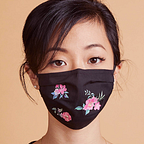This post is from April 2020. Like so many others, I was overwhelmed when I initially tried to buy a face mask.
Here’s what I knew:
- The CDC recommends wearing a face covering in public
- N95 respirators should be left for frontline workers due to global supply shortages
- Surgical masks are designed to be disposed after every use, which means I needed a box of 30 to last a month
This led me to decide on buying a reusable fabric mask. This way, I could wash and reuse the mask as often as I needed. But I still had so many questions. What kind of materials are best? What features should I look for?
I spoke with medical professionals, hospital suppliers, and fabric technicians. Here’s what I learned. The best fabric mask is a balance between water repellency, breathability, filtration, and fit.
Filtration protects against hazardous particles
The better filtration, the better protection. According to the CDC, surgical masks offer protection against large particles and some protection against small particles. N95 respirators offer protection against both.
To put this in numbers:
- According to a study by the ACS, N95 respirators prevent 99.9% of large particles (> 300nm) and 94% of small particles (< 300nm) from penetrating the mask at flow rate of 3.2 CFM.
- Surgical masks tested under the same conditions were filter efficient at 81% for large particles (> 300nm) and 61% for small particles (< 300nm).
Water repellency keeps filtration effective
Think of a mask like a coffee filter. When it’s dry, the grinds sit there. When it’s wet, the coffee seeps through.
Surgical masks are water resistant, which means they protect against “large droplets, splashes, or sprays of bodily or other hazardous fluids.” N95 respirators are fully waterproof — which means you could put it under running water and nothing would go through.
When I went to buy masks from brands like Reformation, I realized they offer no water repellency. According to the WHO, COVID-19 is transmitted through respiratory droplets — which meant that this was a critical performance element.
It’s a trade-off between filtration and breathability
You can’t wear a mask for very long if you’re struggling to breathe. You’re also more likely to subconsciously touch your face to adjust your mask — which defeats the purpose of wearing the mask in the first place.
Here’s the tricky part: materials that offer the best filtration make are also difficult to breathe. To quote the New York Times:
The biggest challenge of choosing a homemade mask material is to find a fabric that is dense enough to capture viral particles, but breathable enough that we can actually wear it.
If the mask doesn’t fit, you lose critical protection
I’m not a large person (5'2", to be exact) and all masks look enormous on me.
Did that matter? Unfortunately, the answer was yes. The same ACS study found that “gaps (as caused by an improper fit of the mask) can result in
“over a 60% decrease in the filtration efficiency.”
And just in case it wasn’t hard enough — speed is everything.
If we could flatten the curve, we could save lives and get the economy back on track.
This means an effective mask today was better than a perfect mask in a month. But everywhere I looked online had wait times of 4–6 weeks.
The e1 mask was designed to strike the right balance for the general public. It is not a medical mask.
Our objective was to achieve performance levels comparable to a surgical mask in terms of water repellency and filtration, with better breathability and fit. We also prioritized designs that could go into production now — not in a month.
Filtration: We opted for a cotton / poly blend, since studies found that this mix outperformed 100% cotton. We designed the mask to feature two layers for additional protection. We also included a pocket if customers wanted to insert their own disposable filters.
Water repellency: This was the hard part. Applying fluid resistance coating typically takes weeks. With some luck, we were able to source a readily available cotton / poly blend with water and stain resistant coating.
Breathability: At 3.4 oz per square yard, the fabric was lightweight to be comfortable enough to breathe.
Fit: We had initially wanted adjustable straps, but the components would take too long to ship. We also prototyped fabric ties — but these slid down our head and required frequent adjustment.
In the end, we opted for 2 sizes, standard and large, to fit the widest range of customers. We also inserted a nose bridge to minimize gaping.
Speed: Sewing factories in New York state were able to produce thousands of mask a week once we were able to secure fabric and supplies.
In normal circumstances, we would not sell this product until we could submit for testing.
We understand the critical need for masks — it’s why we got into this in the first place. In parallel, we are speaking with labs to get our masks tested.
This was arguably the hardest product I’ve ever built. It involved a bit of science, supply chain, textile arts — and nagging your roommates to give feedback on every prototype because you can’t do user interviews.
The e1 is Nam & Ko’s first mask. Filtration, water repellency, breathability, and fit are we used to build this mask. And it’s the standard by which we will measure ourselves for every future release.
